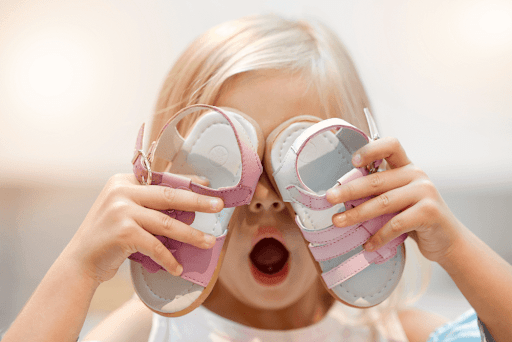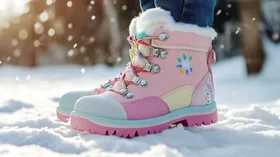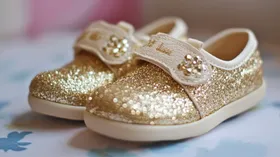Idiopathic Toe Walking in Toddlers: Causes & Treatments
Is your toddler a tiptoe walker? Learn about the reasons behind this gait and how to help them transition to a more natural walking style
Published December 10, 2024.

Have you noticed your child tiptoeing everywhere, with their heels barely touching the ground? What might seem like a cute quirk could be a condition called idiopathic toe walking.
While many children go through brief phases of walking on their toes, persistent toe walking can sometimes signal the need for support. Let's explore this condition and how early intervention can make a big difference.
» Help your kid overcome toe-walking challenges and develop healthy gait
What is Idiopathic Toe Walking?
Idiopathic toe walking is where a child consistently walks on their toes without an apparent medical reason. Research shows that 7–24% of children go through brief phases of toe walking. However, healthcare professionals start paying closer attention when it persists beyond age three.
"Idiopathic" essentially means "of unknown origin"—medical speak for a condition that doesn't have a definitively identifiable cause.
» Try these effective strategies for stopping toe walking
Common Characteristics of Toe Walking
Toe walking isn't just about standing on tiptoes. Here are some key characteristics parents might observe:
- Children maintain a consistent pattern of walking exclusively on the balls of their feet, with heels rarely touching the ground during movement.
- The walking style appears habitual and comfortable for the child, not seeming to cause them discomfort or difficulty.
- Toe walking might be more pronounced during certain activities like running or playing.
- Some children demonstrate remarkable balance and agility while walking on their toes.
» Check out these exercises to help with toe walking
Potential Causes of Habitual Toe Walking
Even though idiopathic toe walking might not have a clear medical cause, it isn't random. There are several factors can contribute to this walking pattern:
- Genetic Predisposition: Family history plays a significant role. Children with siblings or parents who experienced toe walking are more likely to develop the same pattern.
- Environmental Influences: The surfaces children walk on matter. Flat, cushioned environments might delay sensory-motor feedback, potentially encouraging toe walking.
- Behavioral Preferences: Some toddlers find toe walking comfortable or enjoyable. Over time, this can become a habitual walking style.
» Learn if there a connection between ADHD and toe walking
Signs Toe-Walking is Improving
Here are some signs indicating the natural resolution of idiopathic toe walking:
Increased Heel Contact: As the child matures, they should gradually increase the time their heels spend on the ground while walking. This indicates improved ankle flexibility and motor control.
Decreased Calf Muscle Tightness: Reducing calf muscle tightness allows for a more excellent range of motion at the ankle joint. This can be observed during activities like squatting or standing on tiptoes.
Consistent Flat-Footed Walking: The child should be able to walk flat-footed consistently, even during various activities such as running, jumping, or walking on uneven surfaces.
Absence of Associated Symptoms: If the toe walking doesn't cause pain, balance issues, or developmental delays and doesn't lead to compensatory postural changes, it's more likely to resolve naturally without intervention.
Footwear: Insufficiently supportive shoes, especially those with rigid soles or high heels, can limit ankle flexibility and promote toe walking, making it challenging to achieve heel-toe contact.
Long-Term Consequences
Prolonged idiopathic toe walking can lead to several physical issues, including:
- Postural Abnormalities: As a child adjusts to new foot mechanics, persistent toe walking can result in pelvic tilt or increased lumbar lordosis (excessive inward curvature of the lower back). These postural changes can affect overall spinal alignment and potentially lead to pain or musculoskeletal problems later in life.
- Gait Abnormalities: Reduced heel-to-toe motion, a common consequence of toe walking, can alter typical gait patterns. This can result in inefficient walking and running, increasing the risk of falls and hindering the development of fluid and energy-efficient movement.
- Muscle Tightness: The constant strain on the Achilles tendon and calf muscles caused by toe walking can lead to muscle shortening and tightness. This can limit ankle flexibility, making it difficult to squat or stand flat-footed. Additionally, tight muscles can increase the risk of foot and ankle injuries.
- Foot Structure Issues: Prolonged toe walking can impact foot development, leading to high arches, forefoot pain, and decreased shock absorption. These anatomical changes can cause discomfort and functional limitations as the child grows.
If you suspect your child is a persistent toe walker, it's crucial to consult with a healthcare professional for early intervention and to prevent potential long-term complications.
» Support their feet with shoes designed for ankle stability
Treatment for Tippy-Toe Walking
Treatment for toe walking involves several approaches to help children develop a more natural walking pattern. The primary goal is to encourage heel strikes and improve overall gait mechanics.
- Physical Therapy: Specialized exercises help children strengthen their leg muscles and learn proper walking techniques. This includes step-downs, dynamic stretches, and heel walking exercises. Therapists often make these exercises fun by incorporating games and obstacle courses.
- Orthotics: Ankle-foot orthoses (AFOs) help keep the foot in a neutral position and encourage a typical heel-to-toe stride. Custom insoles provide additional support, improving weight distribution and comfort.
- Specialised Footwear: Encourage natural foot development by selecting footwear for unrestricted movement. Opt for shoes with flexible soles, supportive uppers, and adjustable closures to promote healthy gait patterns.
- Surgical interventions: In severe cases, surgery might be considered. Achilles tendon lengthening can help with tight calf muscles by increasing ankle mobility. For structural issues, foot or ankle realignment surgery might be performed to correct deformities and improve walking mechanics.
Early intervention is key to successfully addressing toe walking. The earlier treatment begins, the more likely it is to correct walking patterns and prevent long-term muscle imbalances.
» Encourage their adventures with the best walking shoes for kids
Supporting Your Child's Mobility Journey
Most kids who toe walk simply explore their unique movement patterns, which often resolve naturally as they grow. Parents can take comfort in knowing that toe walking is typically a harmless phase of childhood development that most children naturally outgrow.
If you want to support your child's mobility journey, it can be as simple as choosing the right footwear. First Walkers shoes are designed to provide optimal support for developing feet, featuring adjustable straps, cushioned soles, and designs encouraging natural foot movement.
These shoes offer parents peace of mind and children the comfort and support they need, whether they're exploring the world on their toes or flat feet.
» Don't let toe walking hinder your child's growth. Invest in a pair of supportive shoes today
Disclaimer: First Walkers' information is intended for educational and informational purposes related to toddler footwear and feet. We encourage you to consider individual circumstances and consult qualified orthopaedists about specific conditions.





